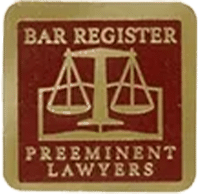
Have you ever been frustrated by getting stuck in the left lane behind a slow-moving car? If so, you may be happy to hear that Oklahoma enacted a law which restricts this type of driving behavior. Basically, our state has made it unlawful to “hang out” in the fast lane.
At Edwards & Patterson Law, our attorneys work with car accident victims and their families in Tulsa, McAlester and throughout Oklahoma. As a result, we keep close tabs on new laws and regulations that affect traffic safety in our state such as the “left lane” law.

Hurt in A Car Accident?
Contact us today for your free & confidential case review. Our team will help you get the compensation that you deserve.
What Are the Basics of the Oklahoma Left Lane Law?
The left lane law – codified at Okla. Stat. tit. 47, § 11-309 – actually went into effect on November 1, 2017. Still, many Oklahoma motorists have not quite figured out what the law means for them and how to comply with it. Here are a few basic points:
- When does the law apply? When you are traveling on a two-lane divided highway, you may not use the left lane except when passing to overtake another vehicle or when road conditions or traffic make it necessary to do so.
- What should you do if you see emergency vehicles? If you are traveling in the right-hand lane and see an emergency vehicle or road construction crew on the right shoulder, you are legally required to at least attempt to change lanes and “move over” or slow down (when moving over is not safe). This rule has been around since 2002, and you are still required to follow it despite the new left lane law. Just don’t stay in the left lane forever. You should change lanes, reduce speed, keep a close eye out for police or other first responders who may be on the side of the road and then get back to the right lane when it is safe to do so.
- What should you do when merging? Another notable exception to the left lane law is merging and traffic flow. On some roads in the state, traffic merges into a highway from the left side. Drivers are expected to still use common sense and good judgment. No one is expected to blast across multiple lanes of travel to get to the right. But once you believe it is safe to do so, you should make an effort to stay to the right unless you are passing.
- What happens if you violate the law? If you are pulled over for driving in the left lane for impermissible reasons, you can subject to a fine as high as $235. It is considered a moving violation, too. So, if you break the law, it can add points to your driving record and possibly raise your insurance rates. As you can see, Oklahoma is taking a pretty aggressive stance on this matter.
Why Did Oklahoma Enact the Left Lane Law?
Proponents of Oklahoma’s left lane law say that its underlying goal is to prevent slow-moving semi-trucks from impeding the flow of traffic by staying in the fast lane. It makes sense. After all, many tractor-trailer combination vehicles have governors on their engines which keep their top speed limited to a reasonable speed. Many speed limiters are set to speeds at or below the average highway speed limits in Oklahoma and other parts of the country.
In 2006, the American Trucking Association (ATA) petitioned the National Highway Traffic Safety Administration (NHTSA) to set a national standard requiring vehicles over 26,000 pounds in gross weight to be outfitted with speed regulators that would restrict top speeds to 68 miles per hour. This is slightly faster than the speed limits in some states that limit semi-trucks to 65 mph, but it is slightly lower than those states that limit top speeds to 70 mph.
How Can the Left Lane Law Help Oklahoma Residents?
If you are driving a regular passenger vehicle in Oklahoma, the new law will hopefully have the long-term effect of keeping semi-trucks and other large commercial vehicles in the right lane. These vehicles will still be allowed to overtake each other in order to maintain a steady pace and make deliveries and pickups on time. However, these drivers will need to quickly and safely return to the right lane as soon as it is clear to do so.
Truck drivers in Oklahoma will no longer be able to “keep the 4-wheelers out” by travelling side-by-side for miles. While the law does not specifically target tractor-trailers in its text, it is clear that larger vehicles – especially those with speed regulators – will be the primary violators targeted.

Hurt in A Car Accident?
Contact us today for your free & confidential case review. Our team will help you get the compensation that you deserve.
What Should You Do If You Are Injured in a Car Accident in Oklahoma?
Oklahoma’s left lane law will hopefully keep traffic moving in a safe and smooth manner on our highways and interstates. As The Los Angeles Times notes, many people believe that the law will prevent accidents by clearing up congestion in the fast lane and reducing incidents of road rage. However, as we have seen over the years at Edwards & Patterson Law, no legislation will entirely keep crashes from happening on our roads. People will continue to break laws and make careless and reckless decisions.
If you are involved in a car accident in Oklahoma, you should take a few simple steps to protect yourself and your ability to pursue a claim for compensation:
- At the scene – You should make sure to stop your car out of harm’s way, check yourself and others for serious injuries and, most importantly, call 911. You will want police to secure the scene and investigate the crash. When you talk to police, answer questions honestly but don’t speculate about who caused the crash. Additionally, you should get the name and contact information of the other driver and any witnesses. You should also take photos of the cars and scene.
- Get medical treatment – You may not immediately detect your injuries due to shock and the “adrenaline” from being involved in a crash. Many people experience brain injury, back injury, soft tissue damage or internal organ injury without realizing it until hours or even days later. For this reason, you should see a doctor as soon as possible if you are not taken by ambulance to the hospital.
- Report the accident to your insurance company – Your insurance policy likely requires you to give notice of the crash. However, you should not give a written or recorded statement until you speak with an attorney from Edwards & Patterson Law first.
- Keep all of your documents – You should make sure to hold on to a copy of your crash report as well as your accident-related bills, receipts and letters and/or e-mails from the insurance companies.
- Refrain from speaking with the other insurance company – If the other driver’s insurance company contacts you and asks for a statement or makes a settlement offer, politely decline to speak until you talk with your lawyer first. In fact, you can simply tell the insurance company to call us at Edwards & Patterson Law.
Get Help from Our Tulsa and McAlester Car Accident Attorneys Today
At Edwards & Patterson Law, we have the experience and resources to help you to pursue full and fair compensation for your injuries after a car accident. We will provide the caring, aggressive legal representation you deserve and fight for you and your future. Contact us today to learn more in a free consultation.
Last updated Thursday, December 5th, 2024













